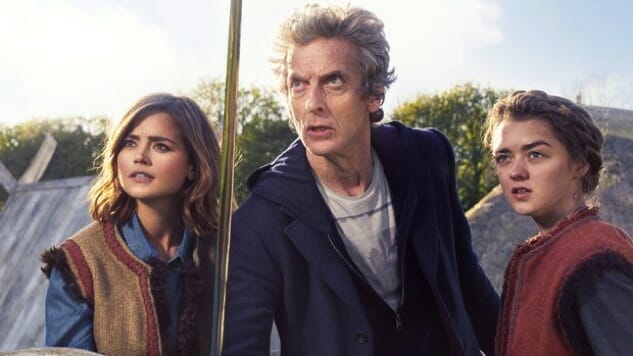Doctor Who: “The Girl Who Died”
(Episode 9.05)

To what length can The Doctor go to save people? As I mentioned in previous reviews, this is a question that the series has explored throughout its 50-year history to varying degrees of success. Is it in the best interest of the universe to potentially shift the course of time and space for the sake of saving a few souls? Or, as the Doctor concisely puts it in “The Girl Who Died”— can he only make “ripples” but not “tidal waves?” If Season Eight found The Doctor asking himself if he was a good man, Season Nine’s focus appears to be measuring his own parameters as the universe’s savior.
“The Girl Who Died” posits itself as one of the biggest challenges to this doctrine, which is funny because the majority of the hour presents itself as a light, frothy historical in the vein of last year’s Robin Hood-themed tale, “Robot of Sherwood.” Whereas Season Two’s previous entries found loopholes where The Doctor didn’t have to come down one way or the other, this episode ends with a major question mark. Yes, The Doctor saves the day, but was his decision dictated by what was right for the greater good, or his own hero complex?
After going into the near future for “Under the Lake/Before the Flood,” “The Girl Who Died” finds The Doctor and Clara landing smack in the middle of a Vikings hunting party where they are instantly captured and The Doctor’s sonic sunglasses are crushed. The two are promptly taken into town where The Doctor catches the eye of Ashildre (Maisie Williams), the teenage daughter of one of the villagers.
As is his design, The Doctor pulls out a yo-yo and tries to uses his “mystical skills” to prove to the villagers that he is the Norse God, Odin. Unfortunately, in a standard case of worst timing imaginable, a helmeted figure claiming to be Odin appears in the sky. The “God” promptly dispatches a pack of armored minions to gather up the village’s strongest warriors. When Clara sees that one of the minions is targeting the young Ashildre, she latches onto her and uses a piece of the broken sonic sunglasses to be beamed away with her. The captured team soon find themselves in the hull of what appears to be a spacecraft. The girls manage to avoid being zapped into nothingness when the “Odin” figure reveals that he’s only interested in killing the warriors so as to drink their testosterone (kind of nasty when you think about it, but I will let that one slide). Clara, in a what-would-the-Doctor-do moment, tries to manipulate the being into traveling elsewhere to harvest warriors’ power. Unfortunately, Ashildre abruptly takes the lead and, per her Viking upbringing, declares war on the creature. And so, “Odin” offers a challenge—he’ll pit 10 of his best soldiers against 10 of theirs.
Back at the village, The Doctor has discovered the identity of the interlopers: they are the Mire, one of the universe’s most feared warrior races. Once Clara and Ashildre return with news of their encounter, The Doctor suggests the village’s best course of action is to straight-up flee. They have no warriors left and no chance of winning such a battle. The villagers, however, stay firm to their Viking mentality, even in the face of certain death. Just as a frustrated Doctor is about to depart, the cries of a frightened young baby (remember, The Doctor can speak baby) encourage him to stay and train this motley crew of non-warriors. Easier said than done, considering none of them have ever held a sword. Indeed, in one of the show’s most hilarious bits of editing, The Doctor announces that the crew is ready to train with real swords—no sooner have they picked up their weapons than we cut to the chaotic aftermath wherein a hut is on fire, one soldier is unconscious and another has fainted from the sight of blood.
-

-

-

-

-

-

-

-

-

-

-

-

-

-

-

-

-

-

-

-

-

-

-

-

-

-

-

-

-

-

-

-

-

-

-

-

-

-

-

-








































